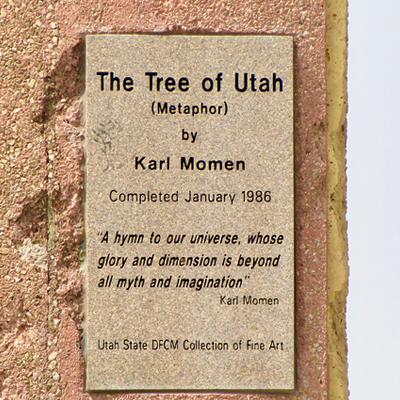Iconic desert sculpture stands tall despite neglect
I think that I shall never see a poem as lonely as “The Tree of Utah.”
This nearly 90-foot, 900-ton sculpture stands alone, yet proudly, in Utah’s West Desert (about an hour and a half from Salt Lake City). It was conceived and crafted in the 1980s by Karl Momen, a Swedish architect, painter and sculptor.
Momen loved deserts. While on a road trip passing by the Bonneville Salt Flats, he was inspired to “plant” a gigantic concrete tree there. This is what he told me when the Tree was just a sapling.
More than 30 years ago, I was a very green, very young Salt Lake TV reporter. I was lucky enough to cover Momen on his tree odyssey. Although there have been tree critics and even protesters over the years, I never considered Momen’s creation to be outlandish. The artist’s passion for his project easily won me over.

Tree of Utah – Chris Vanocur
Given my decades-long penchant for the tree, I decided recently it was time for this old man to go west. So, in early August, I headed toward Wendover to see how the tree was holding up. But paying homage to this work of art wasn’t so easy.
First of all, there are no signs letting motorists know when they’re getting close to the Tree. If you’re not familiar with the terrain, you can zoom right by before even knowing it’s there. In fact, the only highway sign near the Tree warns drivers that only emergency stopping is allowed.
The second, bigger problem is that there’s no pull-off at the Tree, nor is there a parking lot or visitors center. This makes me both sad and angry. Utah has one of the tallest and most interesting sculptures in the country, and there’s no place for people to stop and admire it.
What I found at the Tree made me even more glum. It’s surrounded by a fence, not unlike a caged animal at the zoo. I wondered if this was to keep vandals at bay. After all, Momen’s two concrete acorns near the Tree (and outside the fence) have both been defaced with graffiti. I find it heartbreaking that such a unique work of art has been treated so callously.
While researching this article, I stumbled upon some old YouTube clips of my 1980s reporting on the tree. Besides noting how much dark hair I had then and how bad my early reporting was, I was also struck by something Momen said during the interview as he stood just a few feet from his work: “It’s going to be a landmark for Utah,” he said. “It’s no doubt. I am absolutely sure.”

Tree of Utah
Momen was right. His artistic vision, paid for reportedly with $1 million of his own money, is a nationally recognized roadside attraction. But I worry this landmark is being forgotten and neglected. The biggest proof of indifference is the fact that cars still have to pull over onto the shoulder just to get a good look at it. Not only does the lack of a pull-out create a dangerous situation for those on the roadway but it disrespects the artist’s work.
The Utah Division of Facilities Construction and Management oversees The Tree of Utah but has only a small fund for basic maintenance. While Momen and other Tree lovers would like to see a visitors center, paying for it and an expensive turnout would likely cost millions of dollars. Needless to say, that kind of money doesn’t grow on trees.

Tree of Utah
While it’s official name is Metaphor: The Tree of Utah, it’s also referred to as the Tree of Life. I thought about this during my August visit. While the tree is clearly not alive in the same way other trees are, it’s life-affirming. It lives on inside people like me, even though my once dark and youthful hair now more closely resembles the white tinge of the Salt Flats. I would also like to think the tree inspires the drivers who pass it every day. It’s a reminder, perhaps, that the world is still full of extraordinary things.
I reached out to Karl Momen when I started writing this article, but my email went unanswered. Therefore, it seems only fitting and proper to end with a Momen quote from long-ago days when the branches of his art and my journalism were intertwined. His timeless words are written on a plaque that now adorns the trunk, which says poetically that The Tree of Utah is, “A hymn to our universe, whose glory and dimension is beyond all myth and imagination.”



